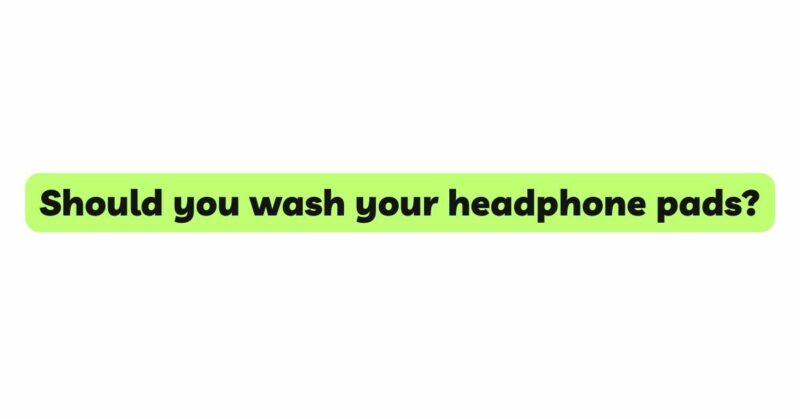Headphones are an integral part of our daily lives, providing us with music, podcasts, and calls on the go. Over time, the ear pads on headphones can accumulate dirt, sweat, oils, and skin particles, leading to hygiene concerns and a decline in comfort. As users, it’s essential to consider whether washing headphone pads is a safe and effective practice. In this comprehensive guide, we will explore the importance of headphone pad hygiene, the types of materials used in headphone pads, the pros and cons of washing, and alternative cleaning methods to help you maintain a clean and comfortable listening experience.
The Importance of Headphone Pad Hygiene
- Bacterial Buildup: With regular use, our headphones come into contact with sweat, oils, and the natural bacteria on our skin. Over time, this can lead to bacterial buildup on the ear pads, potentially causing skin irritation or ear infections.
- Sound Quality: Hygiene is not just about health; it can also affect sound quality. Accumulated dirt and oils on the ear pads can create a barrier that interferes with the acoustic seal, impacting the sound quality and reducing noise isolation.
- Comfort: Dirty headphone pads can become uncomfortable and itchy, especially during long listening sessions. Clean ear pads provide a more enjoyable and comfortable experience.
Types of Headphone Pad Materials
Headphone pads come in various materials, each with its unique characteristics and cleaning requirements. The most common materials used are leatherette, velour, and memory foam.
- Leatherette: Leatherette ear pads are made from synthetic leather and are popular for their durability and ease of cleaning. They offer better noise isolation and are often found on closed-back headphones.
- Velour: Velour ear pads are crafted from soft fabric, providing excellent breathability and comfort during long listening sessions. They are typically found on open-back headphones and offer a more open and natural sound experience.
- Memory Foam: Memory foam ear pads conform to the shape of the user’s ears, providing a custom fit and enhanced comfort. They are often used in high-end headphones for their luxurious feel.
Should You Wash Your Headphone Pads?
Whether you should wash your headphone pads depends on the material they are made from and the manufacturer’s recommendations. Let’s explore the pros and cons of washing headphone pads for each material type.
Washing Leatherette Headphone Pads
Pros:
- Leatherette ear pads are designed to be more resistant to moisture and can be easily wiped clean with a damp cloth and mild soap.
- Washing leatherette pads can effectively remove accumulated oils and dirt, improving both hygiene and comfort.
Cons:
- Excessive moisture or harsh cleaning agents can damage the synthetic leather material, causing it to peel or crack over time.
- Frequent washing can lead to premature wear and tear of the leatherette, shortening the ear pads’ lifespan.
Cleaning Velour Headphone Pads
Pros:
- Velour ear pads can be cleaned using alternative methods, such as vacuuming or dry brushing, to remove surface dirt and dust without damaging the fabric.
- Spot cleaning with a slightly damp cloth and mild soap can effectively target specific stains without saturating the velour.
Cons:
- Washing velour ear pads with water can cause them to lose their texture and become matted, impacting their softness and comfort.
- The delicate nature of velour material requires extra care during cleaning to avoid damage or discoloration.
Cleaning Memory Foam Headphone Pads
Pros:
- Memory foam ear pads are generally not washable, but they are designed to be naturally resistant to moisture and odor.
- Dry brushing or vacuuming can help remove surface dirt and debris from memory foam ear pads without causing damage.
Cons:
- Washing memory foam ear pads can cause the foam to retain moisture, leading to mold growth or deterioration over time.
- Washing memory foam pads can compromise their shape and resilience, reducing their comfort and support.
Alternative Cleaning Methods for Headphone Pads
For headphone pads that are not washable, or for users who prefer to avoid washing, there are alternative cleaning methods to maintain hygiene and comfort:
- Dry Brushing: Use a soft-bristled brush or a lint roller to gently remove surface dirt and dust from the headphone pads.
- Vacuuming: Use a vacuum cleaner with a small brush attachment to remove loose particles and debris from the ear pads.
- Spot Cleaning: For specific stains or spots, use a cotton swab slightly dampened with a mixture of water and mild soap. Gently dab the affected areas and allow them to air dry completely.
- Velour Brush: Some headphone manufacturers offer special velour brushes designed to clean and revive the fabric. These brushes have soft bristles that can help maintain the velour’s texture and appearance.
Conclusion
The hygiene and maintenance of headphone pads are essential for ensuring a comfortable and enjoyable listening experience. Whether you should wash your headphone pads depends on the material they are made from and the manufacturer’s recommendations. Leatherette ear pads can be washed with a damp cloth and mild soap, while velour and memory foam ear pads require alternative cleaning methods to preserve their texture and comfort. Regardless of the cleaning method, it’s crucial to be cautious and avoid excessive moisture or harsh cleaning agents that can damage the ear pads.
For headphones with non-removable or non-washable ear pads, regular dry brushing and vacuuming can help maintain cleanliness and prolong the ear pads’ lifespan. By adopting appropriate cleaning practices and understanding the specific requirements of your headphone pads, you can ensure a clean, comfortable, and hygienic listening experience for years to come.


